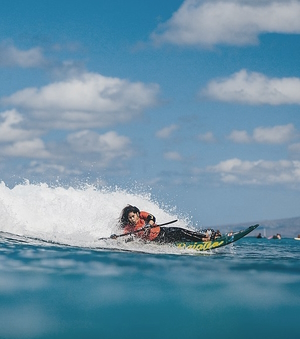Adaptive Surfing
This article explores the world of adaptive surfing, its origins, the adaptive equipment used, and the potential impact it has on the lives of those involved.
Surfing, with its exhilarating rush and powerful connection to nature, has long captured the hearts of thrill-seekers worldwide. However, the beauty of this water sport extends beyond its aesthetics; it holds the power to transform lives. Adaptive surfing, a growing movement within the surfing community, is breaking down barriers and enabling individuals with physical disabilities to experience the joy, freedom, and healing that surfing offers.
Origins and Growth
 Accessible Surfing: Pictured here is Meira Waveski conquering the waves. Photo Source: Wikipedia
Accessible Surfing: Pictured here is Meira Waveski conquering the waves. Photo Source: WikipediaThe origins of adaptive surfing can be traced back to the 1970s in California, where pioneering individuals with disabilities started experimenting with modified surfboards. As the movement gained momentum, organizations such as Life Rolls On and Access Surf, and High Fives emerged, dedicated to providing opportunities for people with disabilities to engage in the sport.
Since then, adaptive surfing has experienced exponential growth, expanding its reach globally and inspiring countless individuals to overcome physical and emotional challenges through the power and joy of surfing.
Adaptive Equipment
Adaptive surfing relies on a range of specialized equipment designed to accommodate various disabilities and enhance safety. Depending on the surfer's needs, adaptive equipment may also include beach-accessible wheelchairs, adaptive wetsuits, and assistive devices for paddling.
Surfboards equipped with straps, handles, and flotation devices offer stability and assist individuals with limited mobility or balance impairments. Advances in technology have led to the development of innovative equipment, such as motorized surfboards and wave pools, further broadening the possibilities for adaptive surfers.
Empowerment and Inclusion
According to surfing enthusiasists with disabilities, adaptive surfing goes far beyond the physical act of riding a wave. It fosters a sense of empowerment and inclusivity, breaking down societal stigmas and challenging perceived limitations.
For those engaging in the support, surfing becomes a transformative experience, offering a unique combination of physical exercise, mental rejuvenation, and a deep connection to the ocean. The ocean's vastness and unpredictability provide a profound sense of freedom and liberation, allowing adaptive surfers to transcend their disabilities and experience a world without boundaries.
Moreover, adaptive surfing communities offer a supportive network, where participants can share their journeys, inspire one another, and build lasting friendships. The camaraderie found within these communities promotes social integration and emotional well-being, combating isolation and fostering a sense of belonging.
Impact on Mental and Physical Well-being:
The physical demands of paddling and maneuvering through waves provide a full-body workout, improving cardiovascular health, muscle strength, and coordination. .
Moreover, the rhythmic motion of the ocean, combined with the release of endorphins, promotes mental relaxation and reduces stress and anxiety. For individuals with post-traumatic stress disorder (PTSD), adaptive surfing can be particularly beneficial, offering a natural form of therapy and healing.
The psychological impact of adaptive surfing is equally significant. Participants often report increased self-confidence, a sense of accomplishment, and improved self-esteem. The challenges faced in the water transfer to everyday life, instilling resilience and determination. Adaptive surfing empowers individuals to redefine their identities beyond their disabilities, reinforcing a positive mindset and inspiring others to overcome obstacles.
Conclusion
Adaptive surfing can be a powerful force for change, challenging societal norms and redefining what is possible for individuals with disabilities. Through adaptive equipment, inclusive communities, and the reported therapeutic benefits of the sport, adaptive surfing can provide an avenue for personal growth, physical well-being, and emotional healing. As this movement continues to gain recognition and support, it is paving the way for a more inclusive society, where everyone, regardless of ability, can experience the transformative power of riding the waves.
For a list of other adaptive sports activities visit: wheelchair sports activities.
Related Information - Adaptive Surfing
Wheelchair Racing
Wheelchair Golf - Adaptive Golf
Wheelchair Basketball Rules
Wheelchair Football
Wheelchair Soccer
Wheelchair Dancing
Wheelchair Rugby
Wheelchair Accessible Hunting
Wheel Chair Curling
Wheelchair Tai Chi Chuan
Wheelchair Fencing
Adaptive Snowmobiling
Popular ArticlesTypes of Mobility Chairs Wheelchair Sports Activities Helpful Resource Organizations Mobility Scooter Buying Tips Portable Ramp Options |


